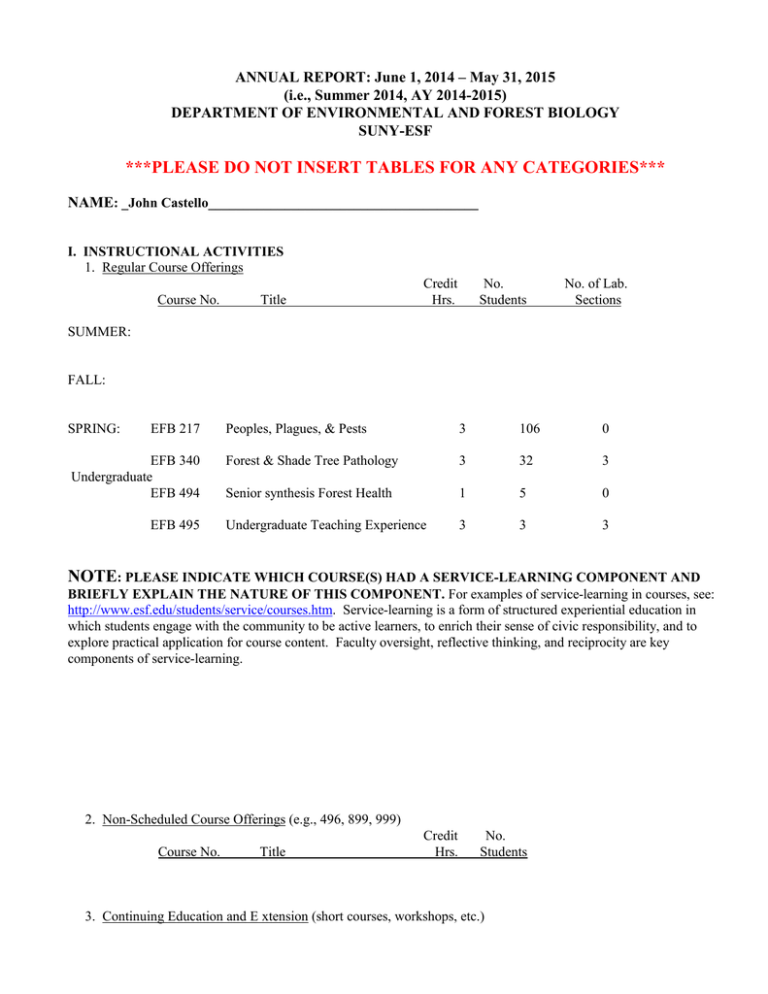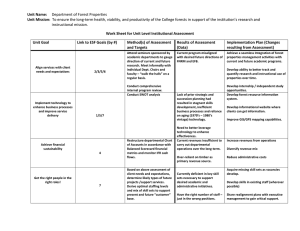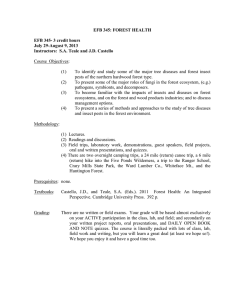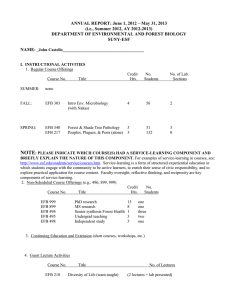ANNUAL REPORT: June 1, 2014 – May 31, 2015
advertisement

ANNUAL REPORT: June 1, 2014 – May 31, 2015 (i.e., Summer 2014, AY 2014-2015) DEPARTMENT OF ENVIRONMENTAL AND FOREST BIOLOGY SUNY-ESF ***PLEASE DO NOT INSERT TABLES FOR ANY CATEGORIES*** NAME: _John Castello_______________________________________ I. INSTRUCTIONAL ACTIVITIES 1. Regular Course Offerings Course No. Title Credit Hrs. No. Students No. of Lab. Sections SUMMER: FALL: SPRING: EFB 217 EFB 340 Undergraduate EFB 494 EFB 495 Peoples, Plagues, & Pests 3 106 0 Forest & Shade Tree Pathology 3 32 3 Senior synthesis Forest Health 1 5 0 Undergraduate Teaching Experience 3 3 3 NOTE: PLEASE INDICATE WHICH COURSE(S) HAD A SERVICE-LEARNING COMPONENT AND BRIEFLY EXPLAIN THE NATURE OF THIS COMPONENT. For examples of service-learning in courses, see: http://www.esf.edu/students/service/courses.htm. Service-learning is a form of structured experiential education in which students engage with the community to be active learners, to enrich their sense of civic responsibility, and to explore practical application for course content. Faculty oversight, reflective thinking, and reciprocity are key components of service-learning. 2. Non-Scheduled Course Offerings (e.g., 496, 899, 999) Course No. Title Credit Hrs. No. Students 3. Continuing Education and E xtension (short courses, workshops, etc.) 4. Guest Lecture Activities Course No. II. STUDENT ADVISING Title No. of Lectures A. Number of undergraduates for whom you are the student’s official advisor 21_____ and unofficial advisor 0_____ B. Graduate Students: (list name, degree sought, starting date, month & year; if a degree was completed, please give date and full citation for the thesis or dissertation). MAJOR PROFESSOR Jonathan Cale: Began PhD in 2009 – completed PhD in 2014. Dissertation title: New insights on beech bark disease in aftermath forests. Cortney D’Angelo: Began MS degree in symmer 2015. Part time. CO-MAJOR PROFESSOR MEMBER, STEERING COMMITTEE (other than those listed above) Ha CHAIRMAN OR READER ON THESIS EXAMS, ETC. III. RESEARCH COMPLETED OR UNDERWAY A. Departmental Research (unsupported, boot-legged; title - % time spent) Baseline mortality research on IA datasets with Cortney D’Angelo, my new MS student (~10%). B. 1. Grant-supported Research (source, subject, amount - total award and current year, award period starting and ending dates; list graduate research assistants supported by each grant) 2. Research Proposals pending (include information as in B.1., above). 3. Research Proposals submitted, but rejected (include information as in B.1, above) IV. PUBLICATIONS (Full bibliographic citation, i.e., do not use "with Jones," or "Jones, et al."; please list only publications published, in press, or actually submitted during this reporting period --- do not list manuscripts in preparation). A. Refereed Publications -Cale, JA, Ashby, AW, West, J.L, Tele, SA. Johnston, MT, Castello, JD. 2014. Tripartite interactions among scale insects, canker and decay fungi in American beech. Forest Pathology DOI:10.1111/efp.12127. -Cale, JA, Teale, SA, Johnston, MT, Boyer, GL, Perri, KA, and Castello, JD. 2015. New ecological and physiological dimensions of beech bark disease in aftermath forests. Forest Ecology & Management 336: 99-108. -Cale, JA, Teale, SA, West, JL, Zhang, LI, Castello,DR, Dvlin, P, and Castello, JD. 2014. A quantitative index of forest structural sustainability. Forests 2014 (5)7:1618—1634. B. Non-refereed Publications C. Papers Presented at Science Meetings (give title, date, occasion, and location) D. Public Service Presentations (lectures, seminars, etc. to and for the public; give group or occasion, date(s), and attendance) V. PUBLIC SERVICE A. Funded Service (include consulting activities) 1. Government Agencies (Federal, State, Local): 2. Industrial and Commercial Groups, etc. B. Unfunded Service to Governmental Agencies, Public Interest Groups, etc. VI. PROFESSIONAL DEVELOPMENT A. Professional Honors and Awards (for teaching, research, outreach, etc.) B. 1. Activities in Professional Organizations (offices held, service as chairman, member, participant or consultant) 2. Professional Society Memberships 3. Other Professional Activities a. Editorial activity Journal (s) Responsibility Other (books, symposia, etc.) b. Reviewer Journal(s) No. of manuscripts Journal of Forest Research (May 2015) 1 Agency No. of proposals Other c. Participation (workshops, symposia, etc.) Name of workshop, etc. Date Place C. Further Education/Re-training Undertaken, Leaves, Workshops, etc. D. Foreign Travel (Where, When, Purpose) VII. ADMINISTRATIVE AND SERVICE RESPONSIBILITIES (include committee participation) A. Department-level Associate Chair Chair, EFB Promotion/Tenure Committee 2010-2015. Coordinator for Forest Health Major, Supervisor for Joanne Rappleyea (EFB secretary). Co-organized EFB spring awards ceremony with S. Polimino. B. College-level C. University-wide, including Research Foundation VIII. SUMMARY OF SIGNIFICANT ACTIVITIES AND ACCOMPLISHMENTS DURING THIS REPORTING PERIOD, ESPECIALLY THOSE MOST NOTEWORTHY AND RELATIVE TO THE COLLEGE’S AND DEPARTMENT’S MISSION. Ne Raa One paragraph on each of the following (i.e., three paragraphs total) would be most helpful: this past year, what have you done for our students, department/college, and self professionally? NOTE: The information in this section (along with the supporting specific information elsewhere in this report) should be your strongest case for being considered for a discretionary raise (when available), which I’ll continue to award based on your contributions to the department and college this reporting period. ESF and ESF: I have been actively engaged as Chair of the departmental P/T Committee to complete revision of the departmental protocol for evaluation of faculty for promotion and tenure decisions, and to assess faculty/departmental productivity over time. I have overseen the successful review of Drs. Farrell and Dovciak for promotion to Professor and Associate Professor, respectively. I will continue to assist the Chair as Associate Chair as long as he requests my help. MYSELF: I published the first of several manuscripts on my baseline mortality method to evaluate forest mortality attributed to climate change. It was published in Forests 2014. Jon Cale and I published three manuscripts resulting from his PhD research this year alone. We are working on several others. The baseline mortality methodology is being considered for patent and copyright protection. ESF STUDENTS:Steve Teale and I cpntinue to teach EFB 217 to over 100 students for the 10th year. We will continue to do so as long as it remains popular. I oversee the Senior synthesis course for the forest health majors. This year seven majors completed their degree in Forest Health and presented their senior synthesis projects. John Cale completed his PhD, and is now a postdoc at Univ of Alberta. IX. A. FUTURE PLANS, AMBITIONS, AND POTENTIAL CONTRIBUTIONS FOR YOUR OWN PROFESSIONAL DEVELOPMENT AND THE ENHANCEMENT OF THE PROGRAM IN ENVIRONMENTAL AND FOREST BIOLOGY (brief summary) B. PROJECTED ACTIVITIES FOR NEXT YEAR I am still attempting to publish two additional manuscripts utilizing our baseline mortality method to evaluate forest mortality attributed to climate change The second manuscript is nearly ready for submission to Forest Science. Cortney D’Angelo and I wiIl begin research with the Forest Inventory and Analysis Program of the USDA to use FIA data with our baseline mortality software to demonstrate its effectiveness in evaluating the impacts of climate change on forest health. There is one more beech bark disease manuscript from work completed this year by Jon Cale that yet needs to be published. I work constantly on behalf of our undergraduates. I teach three formal courses to about 150 undergraduates each year. I coordinate forest health major, I supervise EFB 494 : senior synthesis in forest health twice each year, usually one or two undergraduates conduct research projects in my lab each year, and usually 2-3 undergraduates are teaching assistants in my pathology course each year. 1. Summer 2015 a. Course(s) to be offered: EFB 345 Forest Health at CLBS b. Proposed research activity c. University, professional society, and public service 2. Fall Semester 2015 a. Course(s) to be offered EFB 494:Senior synthesis in forest health b. Proposed research activity Continue MS research work with D’Angelo c. University, Professional society, and public service 3. Spring Semester 2016 a. Course(s) to be offered EFB 217: Peoples, plagues and pests. EFB 340: Forest & shade tree pathology. EFB 494: Senior synthesis in forest health b. Proposed research activity Continue baseline mortality research with FIA datasets c. University, professional society, and public service Continue as Coordinator of Forest Health major Finish service on EFB promotion and tenure committee Continue as Associate Chair





